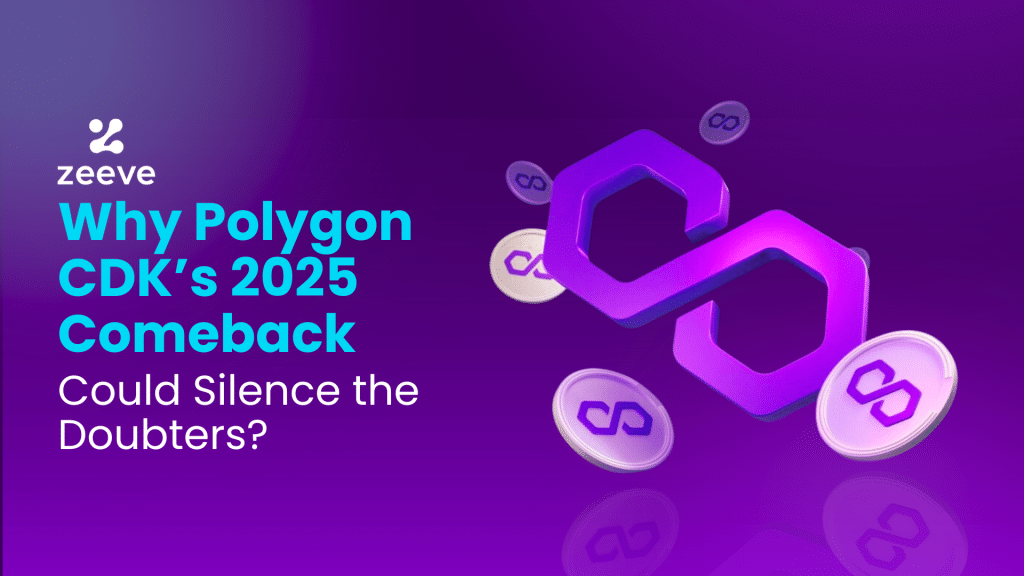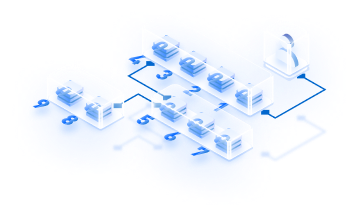Polygon CDK is a breakthrough rollups innovation from Polygon Foundation in 2024. Within just 3-4 months of releases, CDK could aggregate 15+ CDK chains that are already built with this framework, such as Immutable, HaustNetwork, Ronin Network, TON application chain, Wirex, and Astar Network. Meanwhile, 20+ chains will soon tap into the AggLayer ecosystem using Polygon CDK. Not just projects, Polygon CDK in 2025 is set to rise with a bunch of technical upgrades, the greatest partnerships, and several other innovations. Despite all these, Polygon CDK has been challenged a few times, be it for its features, technology, or upgrades. Despite all these challenges, Polygon CDK has pumped up for 2025.
In this article, we’ll look thoroughly look at state of Polygon CDK in 2025. From diving into features to release upgrades and new projects onboarding to additions to its stack, we’ll take a deep dive into all the aspects.

Overview of Polygon CDK
Although Polygon CDK has attained widespread popularity and is familiar to almost everyone, let’s briefly highlight its overview. Polygon CDK is essentially an open-source modular framework to quickly spin up modular L2 chains that are tailored to project-specific requirements for security, scalability, and cost. The launch of Polygon CDK has been so impactful that Polygon Foundation discontinued all of its previous offerings, including Polygon Subnets and Edge. With next-gen concepts like AggLayer, one-token concept, and high-level modularity, Polygon CDK is really taking the L2 industry by storm. In 2025, Polygon CDK is coming with more exciting launches, upgrades, and features to even simplify the modular L2 development for futuristic use cases.
Why Polygon CDK was doubted?
Polygon CDK is a solid answer for Layer2’s scalability, modularity, and high-cost transaction, but it came across few challenges in 2024.
As per L2Beat’s data, 200+ builders showed interest to build with Polygon CDK, but around 8 CDK chains actually launched. That’s because Polygon CDK as a Layer2 rollup stack has been constantly refining to become a full-fledged framework.
Also, the maturity phase of CDK has caused some existing CDK projects to transition to a different rollup stack. For example, Swell– a liquid staking protocol has shifted from CDK to OP Stack. Similarly, Reya Network also announced their switch from CDK to something else. Also, Lido has announced its network sunsetting. This has been a major aspect that caused doubts around CDK, its maturity, and long-term survival.
However, transitioning from Polygon CDK to a different stack cannot justifies lack of capabilities or features in CDK. Instead, it’s the specific requirements of projects that had lead to such decisions. Here’s a tweet from Reya Network team which highlights that Polygon AggLayer and other concept are outstanding, though they have a different requirement at the moment:
Have an announcement tomorrow where we'll be moving away from Polygon CDK to something new 👀
— Simon (@0xSimonJones) March 25, 2024
To be clear – we remain excited about Polygon's aggregation layer in the medium term! But another opportunity came up that makes a lot of sense for us right now.
More tomorrow! 🚀
Now, let’s look at the major painponts that caused doubts around Polygon CDK:
- Dynamic Liquidity & fragmentation issues- In 2024, CDK chains had to go through the challenge highly dynamic liquidity and its fragmentation issues. Throughout the year, Polygon recorded $4.2B total inflows and $250M net flows at, such huge difference reflects the dynamic liquidity aspects, which appeared discouraging for projects planning to build with Polygon CDK.
- Soverignity issues- In absence of a decentralized sequence, which was before the Eggfruit upgrade, Polygon CDK chains struggle to achieve 100% sovereignty. This is a major trouble when sovereignty is a key ingredient for a rollup chain to be modular and highly feasible.
- Major dependency on Ethereum– Polygon CDK chains started by using Ethereum as the single option for settlement layer. Now with alt-DA options and support for native data availability network like Crust Network, Polygon CDK is set to tackle all the challenges that occurred due to Ethereum’s dependency. However, projects still have the choice to choose Ethereum as their settlement layer.
How is Polygon CDK doing a great comeback in 2025?
Polygon has silenced all its doubters through a major and much-needed addition; AggLayer multichain aggregator. AggLayer is right now the biggest competitive edge that Polygon CDK holds.
With AggLayer and fast-proof aggregation, AggChains benefits from an ever-expanding network of aggregated Layer2s in which liquidity is natively unified and fully interoperable to support seamless cross-chain connectivity.
16+ chains are already in the AggLayer ecosystem, including X Layer (OKX), Bethel, GPT Protocol, TON Applications Chain, Merlin Chain, and Moonveil. Now in 2025, Polygon CDK is set to see meteoric rise in the projects because AggLayer has proved its credibility as a win-win solution that aggregates sovereign chains, users, and developers, offering an impressive UX to all.
Let’s dive deeper and learn about the end-to-end benefits of Polygon AggLayer (current and scheduled for 2025), especially for CDK chains:
- Accelerated unified liquidity: Built on top of the unified LxLy bridge, the interop layer efficiently unifies the TVL across diverse Polygon CDK chains, and thus allows for next-gen possibilities like near-instant confirmation, atomic Layer2→Layer2 transactions, friction-free asset transfer, and more. CDK chin buiders are now dedicated on their use cases, instead of stressing about liquidity or users bootstrapping. In 2025, chain aggregation will be even accelerated, allowing for asynchronous inter-chain transactions while making TVL of all chains more seamlessly accessible to CDK chain builders and network users.
- Native tokens concept- Each CDK chains in the AggLayer ecosystem will use a single bridge contract. This ensures assets in the AggLayer are native and never wrapped, offering a better UX and remove intermediaries.
- Shared sequencing- CDK chains in AggLayer ecosystem will be able to use shared sequencers to efficiently execute cross-chain transactions, achieving near-instant finality, as required. A good example of shared sequencer is Cero Network, which is designed specifically for modular L2/L3 chains building with Polygon CDK and similar stacks. Read more about Cero and its comprehensive offerings here.
- Lower cost for ZK proof verification- The AggLayer exclude the need for fee-extracting intermediaries, and hence the cost for ZK proofs verification will be gradually reduced among all the CDK chains.
- Chain state accounting- AggLayer implements a robust chain state accounting method through pessimistic proof. This is a novel form of ZK proof designed to maintains security for all the assets on the AggLayer’s unified bridge. To do this, chain state accounting keep track of all the bridge activities and ensure no chain can withdraw assets more than the deposit.
Want information on AggLayer’s development? Here’s a tweet from Polygon’s founder that mentions quick overview of AggLayer’s Devnet, Testnet, and Mainnet launch:
Hey guys, quick update on Agglayer v0.2 Mainnet.
— Sandeep | Polygon (※,※) (@sandeepnailwal) December 4, 2024
A breakdown of where we're at with Agglayer v0.2 roadmap:
– Devnet – already deployed
– Testnet – scheduled for Dec 9th
– Mainnet – in the coming weeks
This version includes pessimistic proofs, the main component to unify EVM… https://t.co/OaSDC89AMl
Other additions in Polygon CDK?
In 2025, Polygon CDK is coming up with a checklist of feature additions, upgrades, and innovative technologies to tackle all the issues and further compliment the role of AggLayer innovation. Let’s learn about them:
- 1-token concept with ‘POL’- Polygon has already transitioned from MATIC to POL token, which is now the official native token for the entire ecosystem and related activities, such as gas token to incentivize Polygon validators and verify transactions to ensure robust security on the network.
- Efficient stablecoin payment hub: Polygon reportedly had 3M+ active users in 2024. Such a huge number has encouraged Polygon to offer a powerful stablecoin payment hub. Hence, the CDK chains building in 2025 will have access to a powerful and efficient stablecoin payment hub that allow each participants to stake native token and thus secure the network.
- CDK-Erigon sequencer- With Eggfruit upgrade, Polygon rolled introduced a high-performance, fully optimized, and stable cdk-erigon sequencer designed for both the Polygon zkEVM and CDK chains. Through this, Polygon CDK in 2025 will offer builders with benefits like more tps, network stability, doubled-up zkCounters, and depreciation of the legacy RPC node. All kinds of industry-leading use cases, be it DeFi, RWA, gaming, or healthcare– Eggfruit upgrade is created to bring radical changes to each of them. Want to dive deeper into Eggfruit? Need more details? Here’s a detailed article to help you get started:
Polygon’s Eggfruit Upgrade: A Big Step towards a more scalable and efficient zkEVM
- A revamped governance system:
Polygon CDK chains building in 2025 will benefit from a transparent and unified governance based on these two governance pillars–
- Protocol governance.
- System smart contract-powered governance.
The first aspect is to increase transparency and participation across the hub. While the system smart contact is designed to introduce an upgraded framework for governance. This framework ensures that CDK chains can implement a fully transparent, structured, and safety-rich decision-making process.
Building with AggLayer in 2025? Do it on Zeeve RaaS
Polygon CDK is already a top-graded modular rollup stack, and it’s going to be even more popular in 2025 with various advancements in the multichain aggregator. Plus, other additions that has been made to CDK. And, if you are also planning to launch your CDK chain with AggLayer, Zeeve RaaS is the best way to do it. Zeeve RaaS offers you a highly optimized CDK infrastructure to deploy your chains with 60% less cost and 90% less time-to-market. Plus, With 24/7 Enterprise SLA and support, Zeeve RaaS ensures 99.9% availability and consistent performance for your chain.
With our Polygon CDk sandbox tool, you can launch a modular testnet for your CDK chain using 40+ integrations that are supported on Zeeve RaaS platform. The whole setup is optimized for no-code, enabling you to launch mainnet-ready testnet in minutes. For more information about Zeeve RaaS or CDK-related services, connect with our experts. You can also send your queries via mail or schedule a demo call for a detailed discussion.





